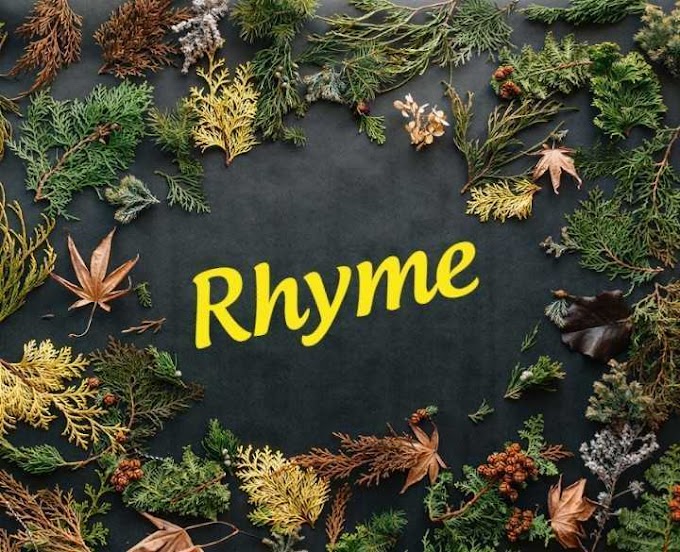LITERARY DEVICES/ POETIC DEVICES
1. RHYME
● What is rhyme?
● Definition of rhyme.
● Meaning of rhyme.
● What is the rhyme scheme?
● Different types of rhymes.
Rhyme is the repetition of the sound or sounds at the end of a line of a stanza in a poem. The sound/s of the ending word of one line is identical or similar to the sound/s of the ending word of another line- followed within the same stanza of the poem.
Eg-
● The music in my heart I bore ,
Long after it was heard no more.
● In the morning I got late ,
I think that was in my fate.
● The curfew tolls the knell of parting day,
The lowing herd winds slowly o'er the lea,
The plowman homeward plods his weary way,
And leaves the world to darkness, and to me.
( Thomas Gray's Elegy Written in a Country Churchyard )
The words 'bore-more', 'late-fate', 'day-way', 'lea-me' are rhyming with each other, they follow the same ending sound. These types of words that rhyme with each other are called rhyming words.
Rhyme Scheme- The pattern of rhymes at the ends of the lines in a poem is called rhyme scheme.
Example- the rhyme scheme of the poem Elegy Written in a Country Churchyard by Thomas Gray is ABAB.
● The curfew tolls the knell of parting day, (A)
The lowing herd winds slowly o'er the lea, (B)
The plowman homeward plods his weary way , (A)
And leaves the world to darkness, and to me. (B)
There are different types of rhymes:
End Rhyme- When the rhyming words occur at the end of a verse line it is called end rhyme.
Internal Rhyme- When the rhyming words occur within a verse line it is called internal rhyme.
Eg-
● In mist or cloud , on mast or shroud,
It perched for vespers nine;
Whiles all the night , through fog-smoke white,
Glimmered the white moon- shine.
(S.T. Coleridge's The Rime of the Ancient Mariner)
There is an end rhyme from lines 2 and 4: 'nine-shine'.
There are internal rhymes within the lines 1 and 3: 'cloud-shroud', 'night-white'.
Masculine Rhyme- When the rhyming is between the final stressed syllables of two lines or when the rhyming words contain a single stressed syllable it is called a masculine rhyme.
Eg-
● The music in my heart I bore,
Long after it was heard no more.
The rhyming words 'bore-more' contain: a single stressed syllable or are the last stressed syllables of two lines.
Feminine Rhyme- When the rhyming is between the last-two syllables of two lines where the second last syllable is stressed and the last syllable is unstressed or when the rhyming words contain a stressed syllable followed by an unstressed syllable it is called a feminine rhyme.
Eg-
● As if her song could have no ending,
And o'er the sickle bending.
The rhyming words 'ending-bending' contain- (the last-two syllables): a stressed syllable (the second-last syllable) followed by an unstressed syllable (the last syllable) of two lines.
Double Rhyme- A rhyme involving two syllables is called double rhyme. Feminine rhyme is also known as a double rhyme because it involves two syllables.
Triple Rhyme- A rhyme involving three syllables is called a triple rhyme. Generally it is used for comic purposes.
Eg-
● The child walked in the dark fearfully,
His heart cried but he smiled tearfully.
The rhyming words 'fearfully-tearfully' contain three syllables, one stressed syllable followed by two unstressed syllables.
Perfect Rhyme- A rhyme where both the rhyming words have the exact- vowel sounds and the number of syllables. It is also known as full rhyme or true rhyme.
Eg-
● 'day-way', night-white', 'bore-more', 'nine-shine'.
Imperfect Rhyme- A rhyme where the rhyming words are formed with similar but not identical or exact- vowel sounds or the number of syllables. The final consonant sounds are similar but the vowel sounds are different. It is also known as half rhyme or slant rhyme.
Eg-
● 'ears-yours', 'moon-run', 'young-song', 'groaned-crooned'.
Eye Rhyme- A rhyme in which the rhyming words look alike and are spelled alike but have different pronunciations.
Eg-
● 'love-prove', 'give-five', 'laughter-daughter', 'pour-hour'.
NOTE- To know the meaning of Poetry or Poetic terms: Syllables, Stressed and Unstressed Syllables, etc, Please click on this link for Poetic Terms - Click Here and for Poetry - Click Here







2 Comments
Hi
ReplyDeleteI like your content and your way of teaching is so easy. Its helped me to easily understand rhyme.
Thanks
I'm most grateful for this post. It's really awesome. Thanks!
ReplyDeleteAny doubts?
Please let us know.